Iron West: The Return of Doug TenNapel
By Mark Wheaton
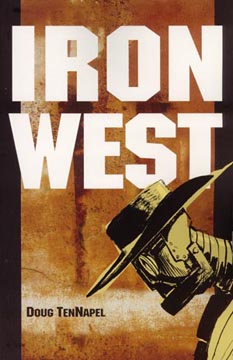 “So…I’m attacked by mechanical outlaws, found by Sasquatch, then healed by a Mi-Wuk Shaman…I can understand that, but why are we weaving baskets?’
“So…I’m attacked by mechanical outlaws, found by Sasquatch, then healed by a Mi-Wuk Shaman…I can understand that, but why are we weaving baskets?’
What an utterly fantastic week for comics: what looks like a good new “Ghost Rider” run (as opposed to last year’s muddled weirdness – I know, I’m in the minority), mad escalation in “Walking Dead,” brilliant new books from Garth Ennis (“A Man Called Kev”) and Jason (“The Left Bank Gang”) and even a promising new #1 in “Scarlet Traces: The Great Game.” On top of that, “The Exterminators” continues knocking them out of the park.
And if that’s not enough, the great Doug TenNapel returns with his latest, hotly-awaited new stand-alone graphic novel: “Iron West.”
A lot of comic creators get tossed around as “the best” – like sports heroes or “Star Trek” cast members – but Doug TenNapel’s status is seldom in question. Between “Creature Tech,” “Earthboy Jacobus” and “Tommysaurus Rex,” the “Earthworm Jim” creator-turned-graphic novelist is just the jams. Dr. Seuss meets Ray Bradbury. H.P. Lovecraft meets Edward Stratemeyer. Horatio Alger meets Stephen King.
And so on.
Though it contains the same kind of great “message” as found in “Tommysaurus Rex,” “Iron West” is nowhere near as epic as “Jacobus” or as surreally religious as “Creature Tech.” In fact, it’s a wild adventurous romp – however written for adults (all the swears!) – that pits a ne’er-do-well, would-be outlaw (Preston Struck) against an army of regenerating alien robots bent on destroying all mankind like Daleks. Joined by a bizarre Indian healer, Sasquatch, a justice-driven Sheriff drawn straight from any number of classic western tales and a beautiful Kansas City…ahem, whore that wonders if Preston will ever do right by her, Our Hero goes through all sorts of mental gymnastics trying to figure out if he can really turn over a new leaf and be the kind of man the town needs him to be against the robot army.
Everything runs like clockwork here, safe as houses, runs like a dream. There’s just such a sense of fun at work in this book combined with a multi-thread, well-woven storyline. While “Earthboy Jacobus” and “Creature Tech” had real moments of seriousness mixed with swashbuckling adventure, “Iron West” comes across as just a wild, western romp with fantastically expressive artwork and great pay-offs (“a wingless dragon!”) that couldn’t be better if it tried.
But isn’t that what we’ve come to expect by now? And how often is it that incredibly lofty and impossible-to-meet expectations are actually met? Only as often as the arrival of the new one from Doug TenNapel.
RATING: 
I Flunked Because My Biology Teacher Hates Me: The Sensational Spiderman # 28
By
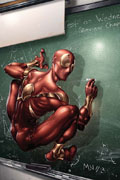 The Clone Saga left fans with a well founded fear that every change from the norm could be a potential disaster and radical change brings a sense of dread. The association with Iron Man and the unmasking of himself has made obvious difficulties unavoidable in Spiderman’s future. Clearly that is the intent of the writers. The only question that remains is whether that intent is wise. Will the events that must occur from the unmasking as well as those that cannot be readily foreseen, make the stories and character more interesting or will it just create a muddle so disturbing that the fanbase turns away from the books? However the bell cannot be un-rung. We are in for a bumpy ride that will either energize the tales or render Marvel a company that makes movies and toys about heroes who no one cares about.
The Clone Saga left fans with a well founded fear that every change from the norm could be a potential disaster and radical change brings a sense of dread. The association with Iron Man and the unmasking of himself has made obvious difficulties unavoidable in Spiderman’s future. Clearly that is the intent of the writers. The only question that remains is whether that intent is wise. Will the events that must occur from the unmasking as well as those that cannot be readily foreseen, make the stories and character more interesting or will it just create a muddle so disturbing that the fanbase turns away from the books? However the bell cannot be un-rung. We are in for a bumpy ride that will either energize the tales or render Marvel a company that makes movies and toys about heroes who no one cares about.
If this issue of Sensational Spiderman is a benchmark, the answer is reasonably positive. Roberto Aguirre-Sacasa, the writer, has reached back to The Marvels, a series of books demonstrating the effects superheroes have on non-powered citizens. That title began with a bang and was tremendously interesting through the first two or three story arcs. It then deteriorated so rapidly that most fans cannot even remember the last few issues. Yet the first few stories are unforgettable. Many fans have longed for more of the quality of those first issues and the presentation of the viewpoints of the common man. We get that here
Peter Parker is presently a teacher. Not just his family is in danger now . The involvement of his students becomes a central part of the plot in this issue. The artwork is exceptional. Online interviews with Clayton Crain have indicated that he works exclusively in Photoshop which, if true, makes this work even more impressive. Painterly but with a touch of "cartoon-ness," the art has a unique and appealing look. That alone makes this issue worth picking up.
The potential of the storyline could make this a pivotal issue. In the real world, repercussions would surely flow. If they do, we shall see the commitment of this publisher to what they have set into motion in short order. Their long term ramifications will not be evident for quite some time and will depend on the readers reactions. The potential is great. So are the perils. Only time will reveal whether Marvel has chosen wisely.
RATING: 
Uncle Sam and The Freedom Fighters Legislate Your Heroes
By
 “Can you imagine living under the totalitarian regime of face-hugging starfish parasites from Planet Wherever? No, they can’t, because I’m out there putting my life on the line to keep this country and this world safe.”— Phantom Lady
“Can you imagine living under the totalitarian regime of face-hugging starfish parasites from Planet Wherever? No, they can’t, because I’m out there putting my life on the line to keep this country and this world safe.”— Phantom Lady
“When Lilliput was on fire, Gulliver urinated on the palace, to save the people… Like the Lilliputians, you want safety and prosperity without sacrifice.” — Father Time
…and with those lines of dialogue Uncle Sam and The Freedom Fighters #1 has eclipsed, in my mind, Marvel’s Civil War as this summer’s best comic book you’ll read about superhero legislation.
In the wake of Infinite Crisis, Americans are questioning the actions of those they once called “superheroes.” The Justice League of
Writers Jimmy Palmiotti and Justin Gray (Jonah Hex) once again prove to be two of comics’ greatest assets, crafting an explosive tale chockfull of political intrigue and interesting moral dilemma. Palmiotti and Gray are in full control throughout this tale using tight dialogue and powerful characterization leading to a final page that damn near dares the reader to not come back for the next installment of what promises to be one of comics most talked reads of 2006.
Artist Daniel Acuna’s work is a true joy to behold. Acuna has a wonderful grasp on exactly just what a comic page needs. Whether it be a vivacious world of today’s idly rich courtesans senator’s daughter, Stormy Knight occupies or the cold, ordered government meeting rooms occupied by Phantom Lady, he knows exactly what little flourish (A small hand gesture, a guy wearing a silly t-shirt ) is needed to make a page sing. Kudos to colorist Javi Montes for making these scenes pop utilizing various hot & cool color palettes.
Uncle Sam and The Freedom Fighters #1 has exactly what I wasn’t finding in Civil War and that’s extremely thought-provoking social commentary. Raising points on all types of questions about the current state of The DC Universe and the world in which we, the readers, live. If you’re going to read one comic this summer about superhero legislation, Uncle Sam and The Freedom Fighters should definitely be it.
RATING: 
Byrd Is Back in Hawaiian Dick: The Last Resort #4
By Jeb D.
 It’s funny, but when issue #1 of Image’s latest Hawaiian Dick miniseries came out in August of 2004, it already felt like it had been forever since the end of the first one. Little did we know that we hadn’t seen anything yet: here we are, two years on, and issue #4 is finally here to wrap things up.
It’s funny, but when issue #1 of Image’s latest Hawaiian Dick miniseries came out in August of 2004, it already felt like it had been forever since the end of the first one. Little did we know that we hadn’t seen anything yet: here we are, two years on, and issue #4 is finally here to wrap things up.
The Hawaiian Dick series tells the story of Byrd, ex-GI turned private eye in post-WW2
The current storyline is yet another riff on Dashiell Hammett’s oft-plundered "Red Harvest", as Byrd finds himself in the middle of a war between Irish-American and Italian-American gangs for control of gambling on the (not yet a state) island. Byrd is hired by the don of the Italian group to find out who’s trying to sabotage his casino opening (and the only answer he’ll accept is that it’s his Irish rival). Of course, things can never be that simple, and Byrd and Mo have been assaulted and near-blown up, while at the end of issue #3…
Oh, the hell with it. Why should I give you a recap when Image themselves can’t be bothered? Seriously, as amazing as it seems, any potential new reader is dropped into the conclusion of the story with no explanation or introduction. It’s taken almost exactly two years for the four issues of this series to come out, and Image can’t even throw in a "previously in Hawaiian Dick" paragraph? I can’t think of a better way to let the monthly comics reader know that he’s just not part of the big picture anymore (certainly they’re not going to have many new readers jumping on). I have no inside information about the delays (though I’m guessing it’s the art, since Moore has had several other new comics come out in the interim, while Griffin needed a fillin artist to get issue #2 out), but as a reader I shouldn’t have to. One way or the other, they’ve made sure that issue #4 enters the world as an orphan.
My suggestion: go to Hawaiiandick.com, and take a look at the sample pages and early online strips. If your interest is piqued, pick up the trade edition of the first series, "Byrd of Paradise." Not only will you get a damn cool story, but you get a boatload of extras, including
Supposedly,
RATING: 
Funny Is As Funny Does: Franklin Richards Super Summer Spectacular # 1
By
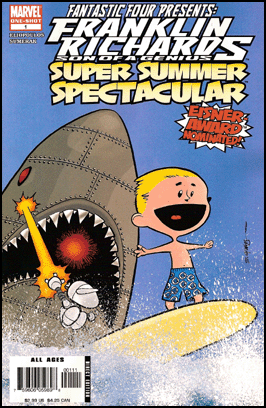 Axiomatic in the entertainment industry is the phrase "comedy is the hardest." This has certainly been proven in the comic book world. One can easily list characters whose success began as hilarious animated cartoons but whose transition to our medium brought forward nothing but images that mimic those seen on the screen. Looney Tunes, Bugs Bunny, most Walt Disney titles, Tom and Jerry, and Woody Woodpecker come instantly to mind. Comic strips of great and deep thought and humor have been transferred to comic books, such as Krazy Kat, and have been so horrible as to be shunned even by children.
Axiomatic in the entertainment industry is the phrase "comedy is the hardest." This has certainly been proven in the comic book world. One can easily list characters whose success began as hilarious animated cartoons but whose transition to our medium brought forward nothing but images that mimic those seen on the screen. Looney Tunes, Bugs Bunny, most Walt Disney titles, Tom and Jerry, and Woody Woodpecker come instantly to mind. Comic strips of great and deep thought and humor have been transferred to comic books, such as Krazy Kat, and have been so horrible as to be shunned even by children.
Some comics have been successful. Asterix the
Over the past several months and apparently at random, a little sideshow has appeared in Marvel comics featuring Franklin Richards, the offspring of Reed and Sue Richards of The Fantastic Four, clearly intended as a leavening agent in the books. A small dab of humor added to adventure. These separate short stories are clearly influenced by Calvin and Hobbes, the last great comic strip. The wit of that comic strip cannot be overstated and as inspiration it works well. These stories appear unexpectedly and are received with a sense of surprised gratitude. Marvel has included humor within its adventure stories from the beginning. However, the grim attitude that is almost universal in super powered characters today, has enveloped Marvel as well as DC in what is a miasma that is difficult to see a way out of.
Here we have six short stories, unrelated except for Franklin and his robot pal H.E.R.B.I.E. Involved for the most part in activities any child could find themselves part of, but given the twist of parents that are superheroes,
RATING: 
![]()

Children of the Grave
(IDW)
By Jeb D.
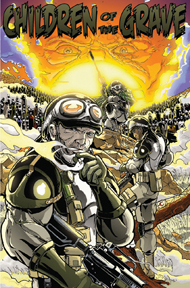 Given their sales figures, you’d imagine that the idea of combining the genres of Tom Clancy and Stephen King would have the bookstands flooded with military-set horror stories. That’s not the case, though—the contrast between the hyper-rationality of the military adventure with the supernatural is a balance not many writers can strike effectively. In Children of the Grave (originally released through Shooting Star Comics, now reissued in a handsome trade edition from IDW), writer Tom Waltz and artist Casey Maloney take a stab at that uneasy alliance, and if they come up a bit short, they make a worthy attempt.
Given their sales figures, you’d imagine that the idea of combining the genres of Tom Clancy and Stephen King would have the bookstands flooded with military-set horror stories. That’s not the case, though—the contrast between the hyper-rationality of the military adventure with the supernatural is a balance not many writers can strike effectively. In Children of the Grave (originally released through Shooting Star Comics, now reissued in a handsome trade edition from IDW), writer Tom Waltz and artist Casey Maloney take a stab at that uneasy alliance, and if they come up a bit short, they make a worthy attempt.
In a conflict between generically-named
The artwork’s spot-on for this blend of story elements: even in black and white the gritty brown of the desert seems to permeate everything, and the attention to detail is admirable. Maloney has a cameraman’s eye, and he’s equally adept with breathtaking landscapes and the details of close-in combat, and the man can do spooky with the best of them. This is a book of terrible beauty.
Up to a point, that goes for Waltz, as well. A former Marine, he inhabits the life of the soldier convincingly, and when the team is devoting itself to the detail of the mission, the story carries real conviction. The firefights are gripping, not only in their visual detail, but in the way Waltz structures them, each encounter almost a complete story in itself.
I’m less sure about his command of the personalities of the individual characters. I assume that the tidy makeup of the group (cliché hard-boiled white leader, cliché Hispanic character, cliché black character) is supposed to be our first clue that there is some larger force at work here (it’s no coincidence these three have been sent on this particular mission), but for page-by-page reading, the constant attempts to use the characters’ speech to remind us of their ethnic origins starts to grate pretty quickly.
The exposition is a bit awkward, too: this is another story where much of the "mystery" derives from the unwillingness of those from beyond to speak a simple, declarative sentence.
The other failing, quite frankly, is the ending. As an affirmation of faith it’s admirable; as a plea for an understanding that would set the madness of the world to rights, it’s welcome; as an appeal to that child that still lives even in the worst of us, and the genuine bonds of our humanity, it couldn’t be more timely. But it’s what they call in
The package is a generous one, with a backup story and a pinup gallery.
I wish I could be more enthusiastic about the book—it’s handled with skill and love and attention to detail; many readers might enjoy it for the artwork alone. Waltz and Maloney appear to be one of those writer-artist teams that function fully in synch with each other, and they’re not afraid to aim high. I won’t be at all surprised to see something truly excellent from them in the future.
RATING: 
Continuity
(AIT/PlanetLar)
By Graig
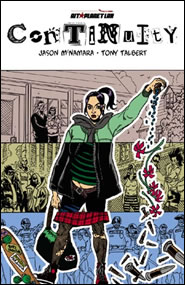 In a dystopian world, a teenage girl finds herself estranged from her family, homeless, strung out on uppers, pregnant, and on the run from the law. All her friends have been killed by the police, since they were, afterall, a criminal network subverting authority at every turn. Close to seeing her end, she seeks refuge in the home of a psychiatrist, to whom she relates her story. Alicia, you see, lives in this horror because she dreamt it into existence. It was while she slept that her mom died, it was while she slept that she was impregnated by her high-school crush, and it was while she slept that she killed him. The last time she slept the world became a much different and much harsher place. The
In a dystopian world, a teenage girl finds herself estranged from her family, homeless, strung out on uppers, pregnant, and on the run from the law. All her friends have been killed by the police, since they were, afterall, a criminal network subverting authority at every turn. Close to seeing her end, she seeks refuge in the home of a psychiatrist, to whom she relates her story. Alicia, you see, lives in this horror because she dreamt it into existence. It was while she slept that her mom died, it was while she slept that she was impregnated by her high-school crush, and it was while she slept that she killed him. The last time she slept the world became a much different and much harsher place. The
This is the tale as told in Continuity, a new original graphic novel by Jason McNamara and Tony Talbert, published by AIT/PlanetLar. It’s fairly high-concept in the Warren Ellis vein, which was immediately appealing, and combining elements of fascism, drug culture, and homelessness seemed like an interesting opportunity to explore deeper issues with a sci-fi bent. Unfortunately, McNamara and Talbert let the opportunity slide by, instead looking at Alicia’s life as if it were an After-School Special. Alicia’s teenage life before she realizes her dreams are affecting reality is about as contrived as they come: her stepmother hates her but her dad is spineless to stand up for her and she pines for the popular star athlete while waving off advances from her best friend. When she runs away from home, she falls in with a cadre of homeless teens who show her the ropes and grace her with all the requisite punk/goth stylings and piercings. Though touching on the idea of these people being a new family for here, little character is infused into any of the characters outside of Alicia, and they’re little more than puppets in overall context.
The narration is quite solid, but doesn’t go far enough in-depth into the kind of madness Alicia should be experiencing with such a degree of sleep deprivation, nor does the book examine the psychoses of living in a world that is not the same as she fell asleep in. The dialogue isn’t rough and, again, falls into clichés and movie-of-the-week melodrama.
The art is heavily inked, reminiscent of early Rick Vietch. There’s an 80’s British comics air to it that works well in the context of alternate worlds and dreamscapes. It fits the punk mold that the writing strives for, and works its hardest to sell it. Overall, it’s a hollow curiosity that just doesn’t dig deep enough into the concepts it plays with.
RATING: 
The Metal Men Archives Volume 1
(DC Comics)
By
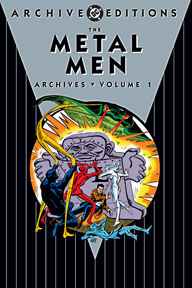 No human could ever do what Superman does. Not Spiderman. Not even Batman. This is part of the mystique, the attraction of superheroes. The imagination can place the reader into the costume of the hero of choice and do what no one else could even attempt. In the age of science however, devotees eventually feel the need to explain how their favorite can accomplish the impossible. To maintain or regain that need for reality fans, mentally torture the laws of physics and create new energies or dimensions as "reasonable" explanations.
No human could ever do what Superman does. Not Spiderman. Not even Batman. This is part of the mystique, the attraction of superheroes. The imagination can place the reader into the costume of the hero of choice and do what no one else could even attempt. In the age of science however, devotees eventually feel the need to explain how their favorite can accomplish the impossible. To maintain or regain that need for reality fans, mentally torture the laws of physics and create new energies or dimensions as "reasonable" explanations.
In the early to mid 1960s DC was as prolific as any comic publisher is likely to ever be. Two series, Showcase and Brave And The Bold, each brought out at least four new titles a year and, if after three issues, the sales’ numbers were sufficient, a title was published on its own. In issue # 37 of Showcase, The Metal Men received their try out and were immediately successful. This volume brings us the three Showcase issues and the first five of the stand alone title.
Each issue follows a similar pattern. The Metal Men, a group of six robots invested withall the potential properties of the metal of which they are composed, meet opposing robots who they eventually defeat but only after heavy losses among their own members. Dr. Magnus, their inventor, then recovers the remains and rebuilds the team to fight the next opposing robot.
Platinum, the female robot, can spin herself into a wire thinner than a human hair. Mercury can expand and flow. Steel is strong, Lead is maliable, Gold can be flattened and enlarged, and Tin can meld and aid the others. Alone they are weak, togeather they are strong. Their powers are clearly impossible. Since they are robots, fans seldom if ever imagine themselves as one of the heroes. This means they had no reason to try to rationalize the clearly impossible powers of the team. Therein lays their true weakness. Combined with the repetitive stories, the lack of reason to legitimize the powers lead to a rapid growth if dis-interest and relatively short life span for the book.
Yet, certainly at first, this is a truly enjoyable book. Most fans around at the time remember this title with great affection because of the human weakness shown by the robots, no doubt brought on by the success of the all too human Marvel heroes that were driving the market at that time. This volume will give you all the fun and avoid the long term disappointment.
RATING: 
![]()

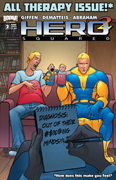 Hero Squared (Vol. 2) #2 (Boom! Studios) – Recapping: Milo Stone, shiftless lay-about and wanna-be director has had his life completely interrupted by an alternate dimensional version of himself, who happens to be a superhero by the name of Captain Valor. Captain Valor’s entire world was destroyed by his ex-girlfriend Caliginous, who is the alternate dimensional version of
Hero Squared (Vol. 2) #2 (Boom! Studios) – Recapping: Milo Stone, shiftless lay-about and wanna-be director has had his life completely interrupted by an alternate dimensional version of himself, who happens to be a superhero by the name of Captain Valor. Captain Valor’s entire world was destroyed by his ex-girlfriend Caliginous, who is the alternate dimensional version of